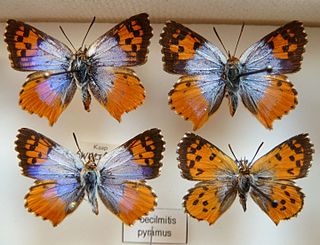Dingane ka Senzangakhona Zulu, commonly referred to as Dingane or Dingaan, was a Zulu chief who became king of the Zulu Kingdom in 1828
Aloeides lutescens, the Worcester copper, is a species of butterfly in the family Lycaenidae. It is endemic to South Africa, where it is known from sandy flats along the Breede River in the Worcester area and the Robertson Karoo in the West Cape.
Chrysoritis daphne, the Daphne's opal, is a species of butterfly in the family Lycaenidae. It is endemic to South Africa, where it is found on the southern slopes of the Kammanassie Mountains in the Western Cape.

Chrysoritis pyramus, the Pyramus opal, is a species of butterfly in the family Lycaenidae. It is endemic to South Africa, where it is found on the northern slopes of the Swartberg, the Kammanassie Mountains and the Langeberg in the Western Cape.

Dingana is a butterfly genus from the subfamily Satyrinae in the family Nymphalidae.

Torynesis is a genus of butterflies from the subfamily Satyrinae in the family Nymphalidae. It comprises five species from South Africa and Lesotho. It is one of the genera in the tribe Dirini Verity, 1953; other genera of this tribe that are found in the Afrotropical Region are Paralethe, Aeropetes, Tarsocera, Dira, Serradinga and Dingana.
Dingana dingana, or Dingaan's widow, is a butterfly of the family Nymphalidae. It is found in the KwaZulu-Natal midfields from the Drakensberg foothills to the Mooi River.
Dingana angusta, the narrow-banded widow, is a butterfly of the family Nymphalidae. It is found in grasslands the eastern highlands from northern Eswatini to Mpumalanga and the Limpopo Province.
Dingana clara, the Wolkberg widow, is a butterfly of the family Nymphalidae. It is only known from the Wolkberg in the Limpopo Province.
Dingana fraterna, the Stoffberg widow, is a butterfly of the family Nymphalidae. It is only known from one hillside to the south-west of the Stoffberg in the Mpumalanga province.
Dingana jerinae, or Jerine's widow, is a butterfly of the family Nymphalidae. It is only known from the upper southern scree slopes of the Kransberg in Limpopo, South Africa.
Dingana alticola, the red-banded widow, is a butterfly of the family Nymphalidae. It is only known from high altitude grassland in the Steenkampsberg area in the Mpumalanga province.

Dingana alaedeus, the Wakkerstroom widow, is a butterfly of the family Nymphalidae. It is only known from high altitude grassland at about 2,000 meters. It has a short flying period in summer. The specific name means “god of the wing” in Latin.
Dingana bowkeri, or Bowker's widow, is a butterfly of the family Nymphalidae. It is found in Lesotho, South Africa, in the Eastern Cape and Richmond and Cradock in the Cape Province.
Dingana clarki, or Clark's widow, is a butterfly of the family Nymphalidae. It is found in South Africa.
Ypthima condamini, or Condamin's ringlet, is a butterfly of the family Nymphalidae. It is found in Ethiopia, from Sudan to South Africa and in western Africa.
Thestor murrayi, the Murray's skolly, is a butterfly of the family Lycaenidae. It is found in South Africa, where it is known from Name Karoo in the West Cape, from the Swartberg to the Kammanassie, Outeniqua and Tsitsikamma mountains to the Groot Winterhoekberge and Baviaanskloofberge in the East Cape.

Aloeides pallida, the giant copper, is a butterfly of the family Lycaenidae. It is found in South Africa.

Catopsilia florella, the African migrant, African emigrant, or common vagrant, is a butterfly of the family Pieridae. It is found in Africa, Arabia and the Canary Islands. Like Catopsilia pomona, this species also has a habit of migration.

The Wolkberg is a mountain range in Tzaneen, Limpopo Province, South Africa. It is a northern termination and a subrange of the Drakensberg mountain range which lines up from Eastern Cape, Lesotho, Kwazulu Natal and Mpumalanga. At 2200 m (7200 ft) above sea level, it is the highest mountain range in Limpopo, together with the Iron crown mountain. Its Meteorological significance is that it brings along cold fronts and is a source of cold winters throughout the Limpopo province, the cold front gets transferred from greater Drakensberg mountains in Kwazulu Natal all the way to the Wolkberg. Without the Wolkberg, Limpopo will not experience cold winters at all. The range extends for about 30 km (19 mi) in a NW/SE direction north of Sekhukhuneland. The nearest towns are Haenertsburg and Tzaneen.





